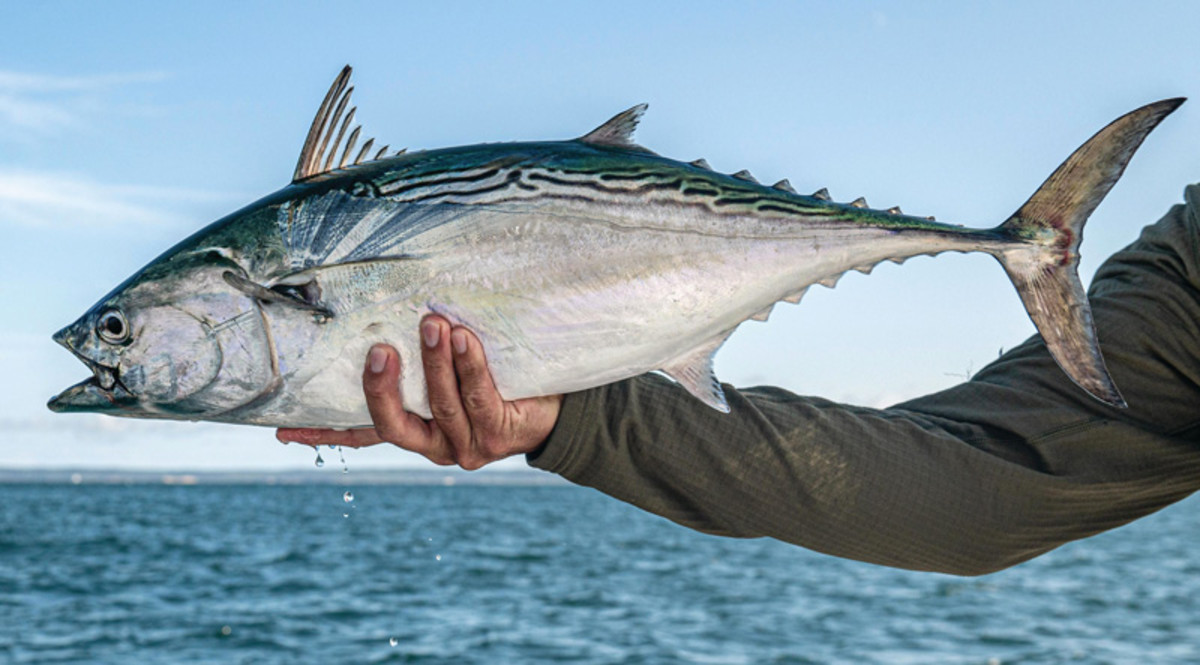
The following is from the Angler’s Journal Article titled – Boyle’s Law
The crisp air around the salt pond is autumnal. Jaime Boyle stands silhouetted against the first flecks of the rising sun tending to the 1992 Hewes skiff that’s been outfitted for his use in the briny waters around Martha’s Vineyard, Massachusetts. He’s not a tall or imposing man, but his shoulder-length blond hair and broad smile break through any pretense that one might bring to this fishery.
“Wish the wind was better and it wasn’t so cold,” he says as we load the skiff and back it down an “unimproved” island ramp.
“Might warm up this week,” I say, trying to make a good impression. He nods and shrugs, and I realize that it’s all right with him either way. The day has started, and there’s a breathy feeling of ease around me. The long drive, the lack of sleep, the problems I left in New Jersey don’t exist now. But I would come to realize that this is how most people feel around Boyle. And in my head, I recall freshman chemistry class and the laws of gases. Pressure is inversely proportional to volume.
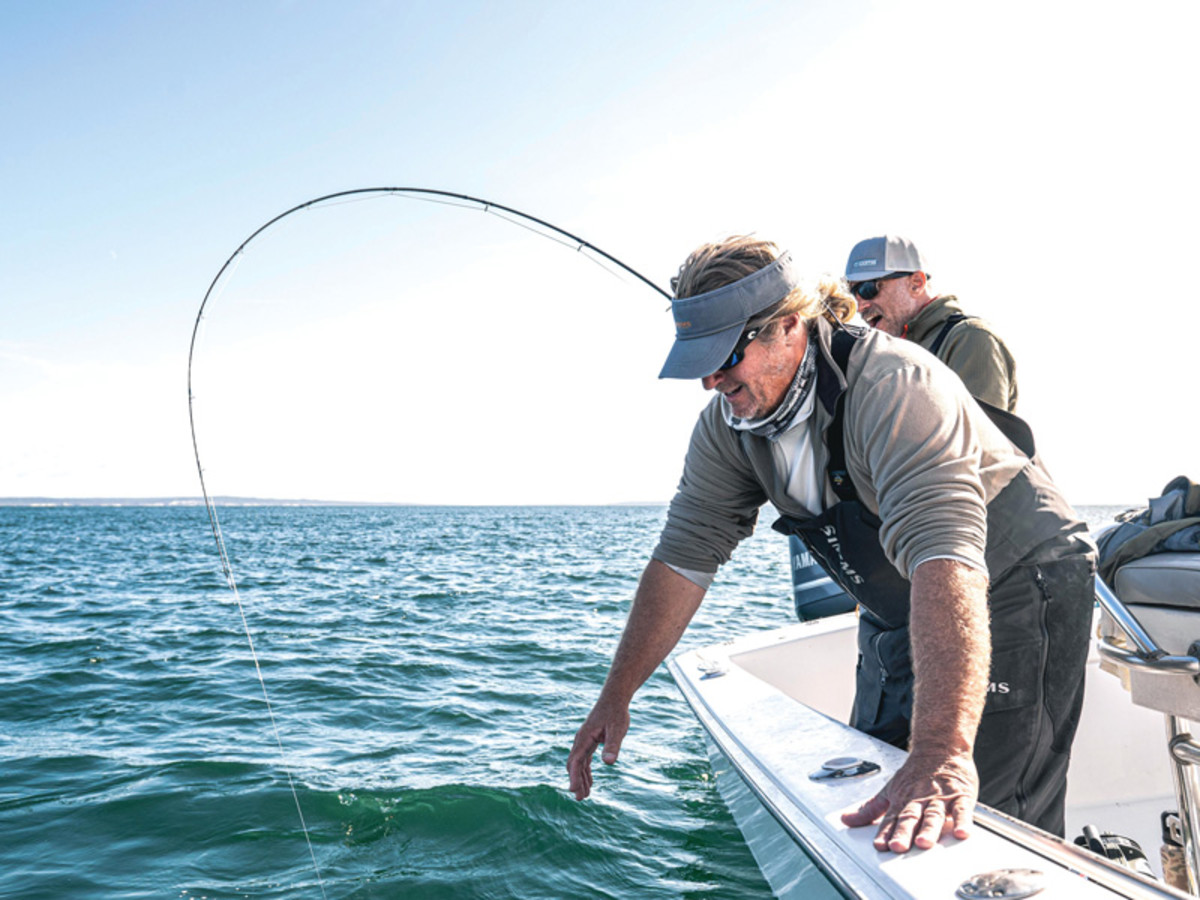
Pressure: that stuff that eats away at our better selves; those twinges of doubt that ruin good fishing trips; the self-imposed exile from the moments in which we find ourselves. While not a chemist, Boyle has certainly harnessed the particles around him. My interpretation of Jaime Boyle’s Law clearly states that on his boat, while he’s at the helm, pressure and volume don’t exist; there can only be the shared time and the fish.
As the first rays of light hit the pond, Boyle moves his skiff through the winding coves and channels in the skinny water. I had only ever waded the pond, but Boyle, at 52, has spent thousands of hours in and around his home waters and can pinpoint rocks, channels and bars from rote memory. “Let’s try a few casts here,” he says, taking the push pole up to the platform.
There should be fish in the area despite the cold, and he tells me about the ebbs and flows of the pond and how stripers find their way in and out as the migration moves up and down the coast. This pond offers perfect access to the hungry fish that might move in to chase sand eels or bunker, and Boyle recounts that it had a spectacular herring run years ago.
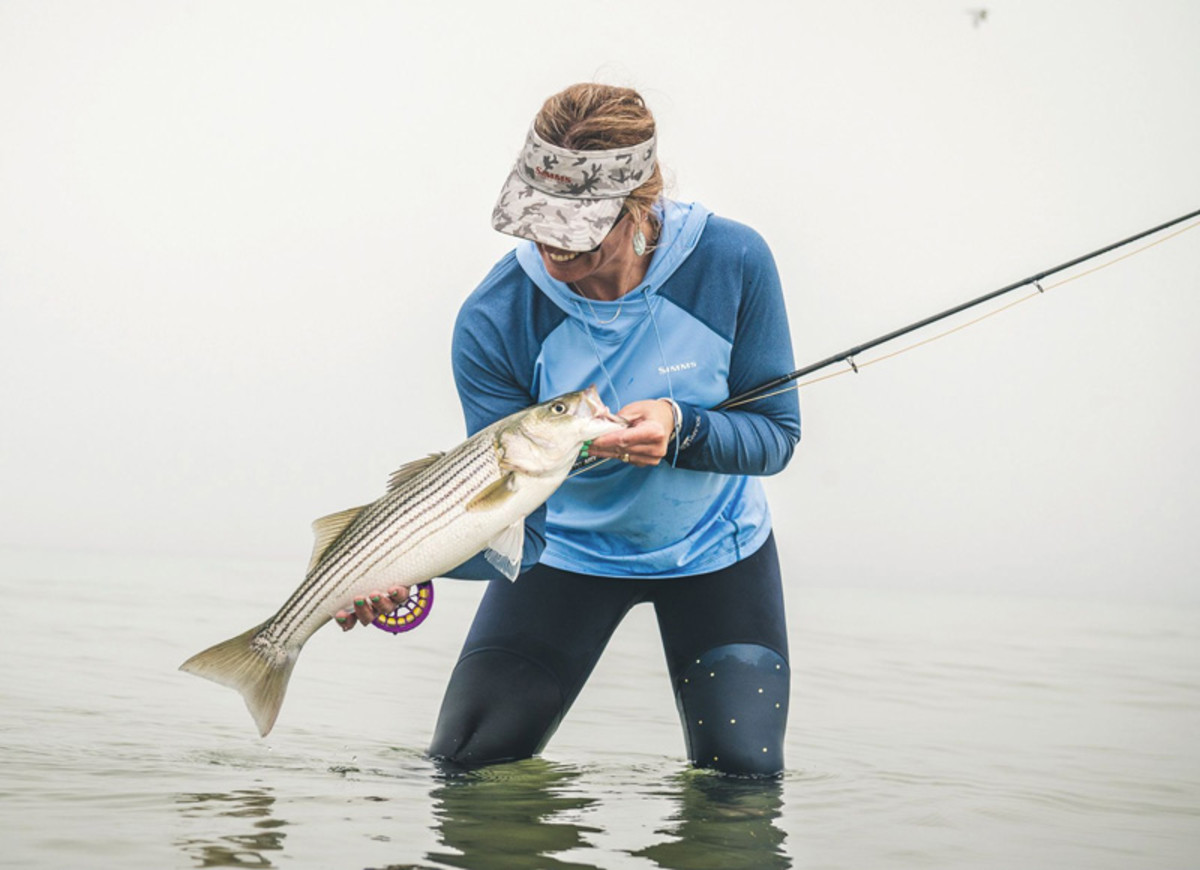
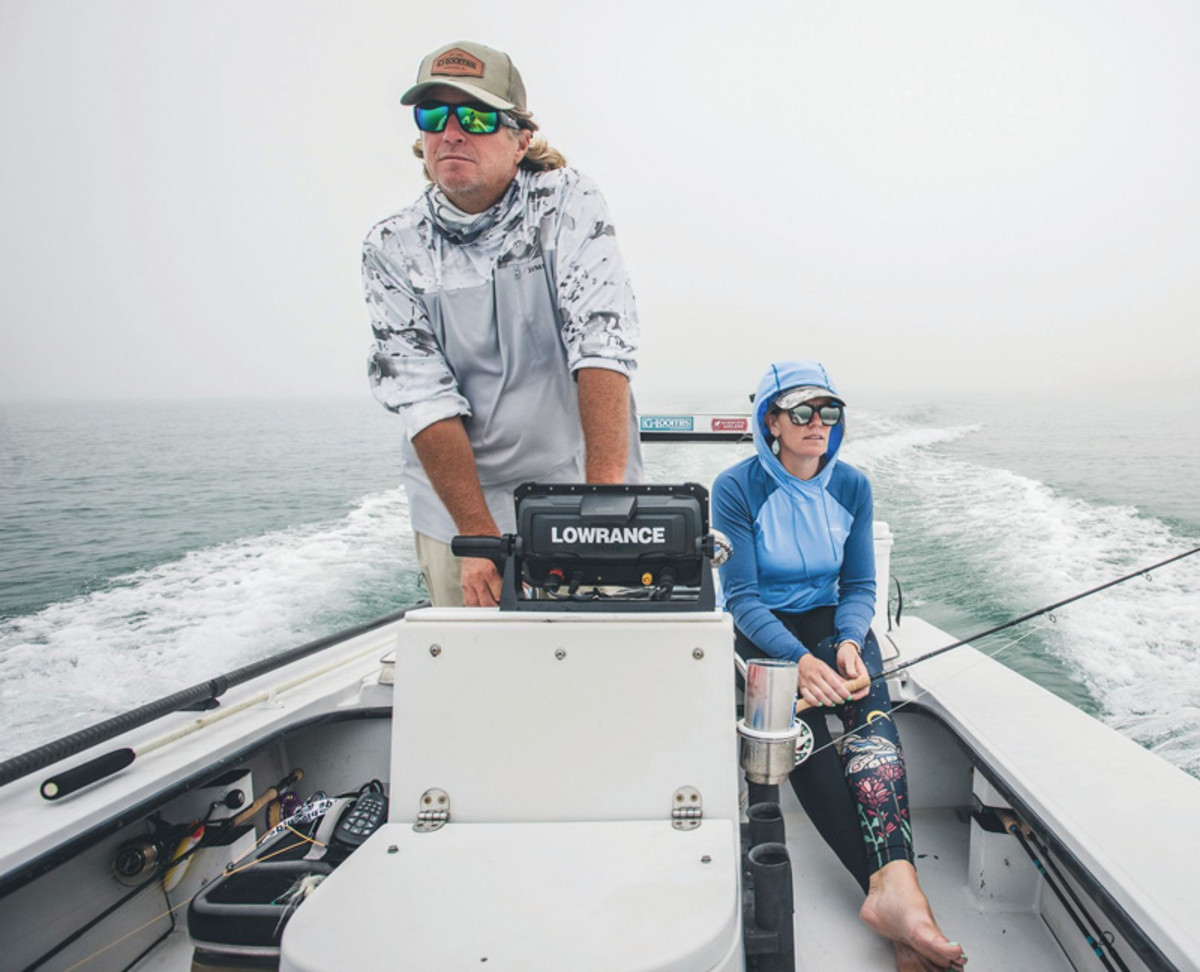
I can’t question his generosity, and before I can strip out line, he’s back on the platform moving us farther along the flat. “So Thompson and I worked out a trade,” he says, resuming his story. “I’d give him sailing lessons, and he taught me the fly rod. I think I was like 19, and from there I never looked back. I had a 13-foot Whaler and started fishing every chance I could.” The Boston Whaler is still in his driveway. He’s given it to his 5-year old son. Now it’s Tyler’s boat.
It’s new-moon dark on a stretch of beach up-island about 30 years ago. A young Boyle stands alongside Bob Popovics and Cooper Gilkes, and they’re listening to what Popovics describes as “bowling balls hitting the water.”
Boyle works for Gilkes at his tackle shop in Edgartown and is a few years into his guiding career, having given Tulane University a chance but deciding that his mind and heart belong to the sea surrounding the Vineyard. Countless nights spent reading the water have given Boyle the edge here, and he’s brought Gilkes and Popovics to a place he’s dialed in. Even Gilkes is astounded at the sight. The three men look at each other, wondering who’ll cast first. Boyle fires and hooks into a 20-pound fish.
“This was our first trip to the Vineyard,” Popovics recalls, “and Jaime couldn’t have been much older than 20-something. We’re with Coop, and we watch Boyle hook into these monster fish. But that’s how the night went. He found a spot where they were feeding on squid. The squid were feeding on little sand eels, and it was just a melee.”
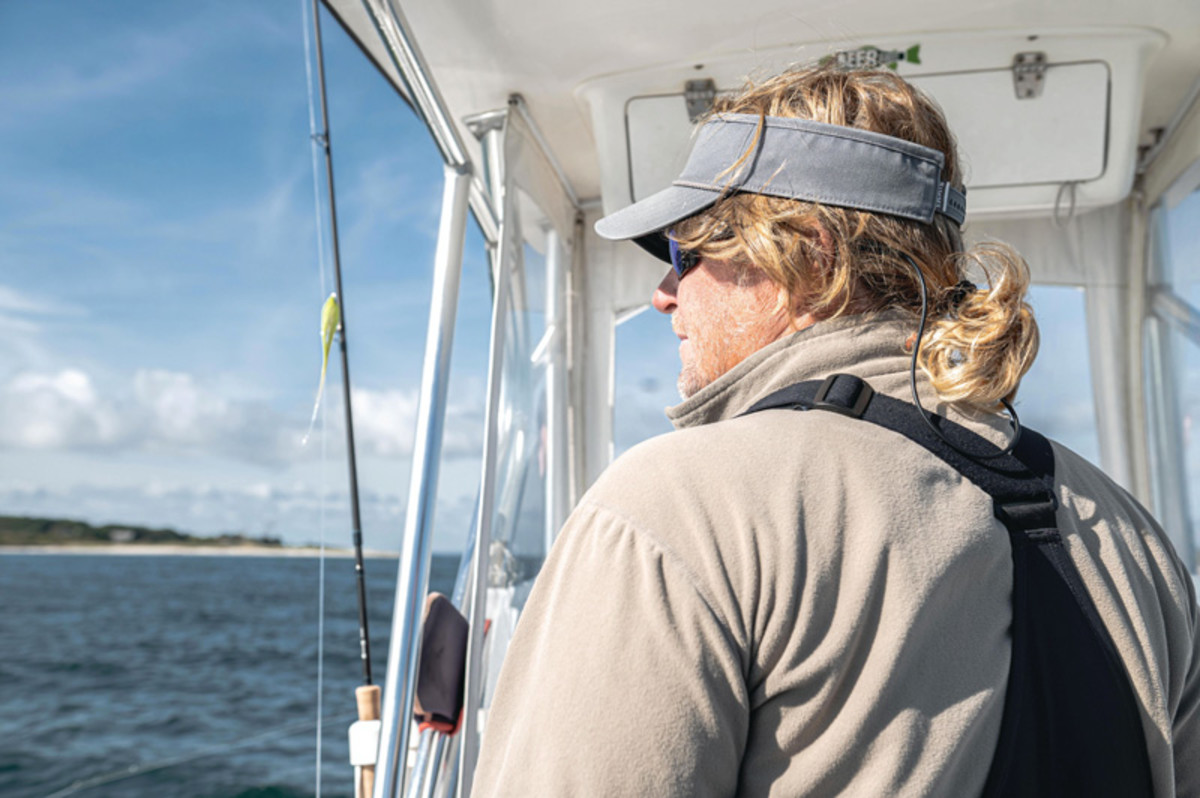
Forty-inch fish are caught and released with elation throughout the night. Boyle is proud of himself. Time and effort have paid off. Those nights without sleep culminated with putting Popovics on a night he would never forget. As the fury of fish-fighting wears, the men hear a “roar coming down the beach,” as Popovics tells it. They hold their casts, and Popovics sees and hears “fish flying through the air and landing on the water. It could’ve only been a shark that was rushing underneath these giant bass,” he says. The action doesn’t cease.
Gilkes thinks his young shop attendant is going to ask for the morning off, but instead Boyle says, “Coop, look at that. There must be a fire on the Cape.”
Gilkes turns and sees the fire-red glow coming from Cape Cod. “Yeah, you’re right,” he says as both men stare. A former firefighter, Gilkes wonders whether they’ve called in multiple departments. The blaze looks intense. They gaze for a long while, mesmerized. Finally, Gilkes puts his hand on Boyle’s shoulder. The young man turns for a shined pearl of wisdom from the older man about the frailty and finality of life, but instead Gilkes smiles wide. “Jaime, that’s the damn sunrise.”
“Jaime Boyle is a fisherman’s fisherman,” Popovics tells me. I had known Boyle’s boat in and around the Vineyard primarily because any time I’d arrive on a spot, Boyle would already be there or be on his way out. His clients are privy to an encyclopedic knowledge of the
waters around Cape Cod and Martha’s Vineyard. The man has put time and energy into knowing exactly where to be and for how long.
As we continue to pole across the pond, the pale light of morning fills the air. Fish are active, and we trade time with the rod. He keeps his trolling motor going, so I don’t have to pole, for which I’m secretly thankful. Boyle casts with long, arching loops that land on the water as if he were placing Catskill dries instead of Vineyard hollows.
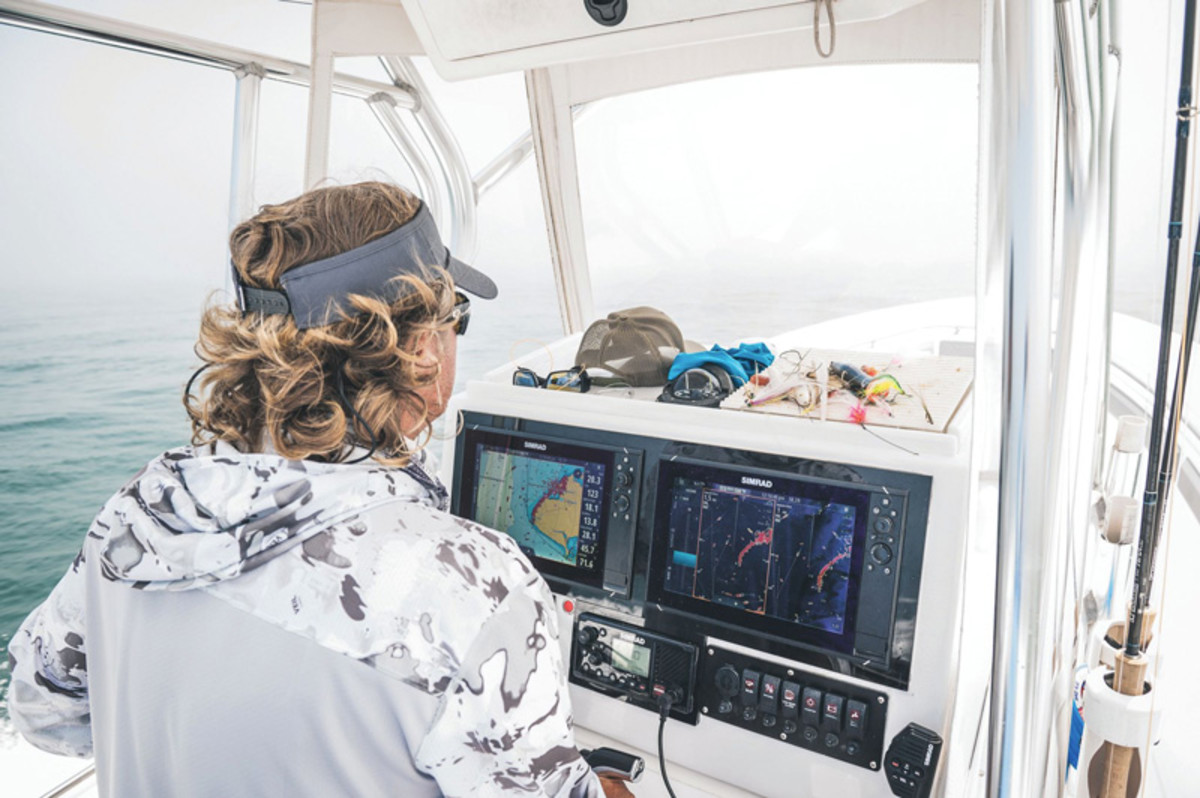
“Tell me about the ASGA. How did you get involved?” I ask, referring to Boyle’s membership on the board of the American Saltwater Guides Association, one of the most successful lobbying and advocacy groups for striped bass conservation.
“It’s funny, I didn’t even know I was on it until [Tony] Friedrich and [John] McMurray sent me the first meeting invite,” Boyle says. “But once I heard what it was about, I knew I had to be involved.”
During the past three years, the ASGA has successfully rallied anglers from Maine to Washington, D.C., around the cause of protecting the striped bass and bluefish coastal fisheries. Friedrich, a gravel-voiced Marylander and vice president and policy director with the group, tells me later that “Jaime’s made for this work, not for an office.” Friedrich extols Boyle’s virtue as a captain and a man. “All of us, including Jaime, are doing this for our kids.”
“The ASGA is doing it for the right reasons,” Boyle says as he brings in a schoolie. He’s careful to barely lift the fish from the water before sending it back swimming. He pauses at the gunwale and rinses his hands. I see in his face a real fear and concern for the fishery. But he doesn’t preach or wax poetic about how great it “used to be.” It seems he’s projecting some far off time and place when a morning full of feisty schoolies was a day that wouldn’t even make a logbook entry.
As Friedrich puts it, “[A lot us feel] like we’re just going out to remember things, and if we don’t do something now, it’s going to be too late.”
“Maybe things are looking up. There’s been good news recently,” I say, referring to the success ASGA had in reshaping Amendment 7 of the Striped Bass Fishery Management Plan.
Boyle shakes his hands dry. “I’ve got a buddy of mine who’s a commercial fisherman in Menemsha,” he says quietly and calmly. “He said to me the other day there should be a moratorium again.” I nod.
When it’s in everyone’s best interest to ease the pressure on the fish, it’s frustrating for those who care about opportunities wasted and squandered. This is the closest to angry I see Boyle get. No hellfire and brimstone, just stiff logic and quiet care. Boyle seems to be thinking of 5-year old Tyler and the notion that perhaps he won’t see days like today, when schoolies are plenty, or days when 40-inch fish were the norm for an evening under the island’s dark skies.
“What’s the thing, Jamie? What makes you keep coming back every day?” I ask as a light drizzle falls.
He casts and strips quickly. “Every day’s different, you know?” he says “And just the people I get to meet. I like the variety of people. I’ve got some guys that have been with me for 25-plus years. They brought their kids and now their kids bring kids. Guys that were little …” — he strip-strikes and turns to smile at me as the rod bends — “… now they show up driving.”
The schoolie he brings in could be on its first migration. “Even the little ones like the Hollow,” Boyle says, removing the white Hollow Deceiver from the fish’s jaw. The fly was far too big for its mouth, yet it was devoured nonetheless.
If you’ve ever thrown a fly in a rip or pond in the Northeast in June or August, chances are good that you were throwing a variation of Boyle’s Red Can Squid or Bonito Bunny. The squid fly is derived from Popovics’ Hollow Squid, but with the eyes superglued directly to the hook shank instead of Popovics’ method of using heavy monofilament.
The Bonito Bunny is a favorite false albacore fly, but it’s really the only sure thing for the wily Atlantic bonito that prowl the rocky waters off the Elizabeth Islands in August and September. Boyle’s 24-foot Silverhawk, aptly named Boylermaker, is inevitably the first boat on a school of bonito. He’s usually had his fill by the time other boats arrive because of the industry he’s put in to understanding where and how the bonito school up and attack bait. Bonito, like false albacore, prefer the rocky inlets and coastline of the Elizabeths and can sometimes corral bait so tight to shore that fish get pushed up by the breakers onto the craggy coast.
“The Bunny just came together based on weight and wiggle,” he says referring to the palmered cross-cut rabbit strip on the hook shank and the brass coneheads that most tie in for extra dive as the fly is stripped. Bonito have small teeth, though, and Boyle knew he needed a fast tie because the fly would inevitably be shredded after a few bites.
The bite turns off around midday. Boyle and I are chapped from the wind. The cold has found its way into every porous point on our layered selves. We set about hauling the skiff and talk about our respective sons. He tells me of Tyler’s prowess in class, and I reciprocate with stories of Matthew and Nathan. We make plans for future bonito trips in warmer weather.
Boyle’s Law, I learn, is a state of being, more so than anything tangible. I know his, like most of our lives, is imperfect and difficult. The last thing Boyle may have wanted to do this day was pole around a windswept salt pond with a less-than-perfect caster, yet his attitude and effort chasing fish is infectious. He exudes no pressure and puts forth the tranquility of someone content with the place, time and circumstance. It’s the kind of thing that comes with knowing you put the time in to succeed.
As I drive home early the next morning, I imagine Boyle has already come and gone on the water. He’s never one to rest on laurels, and I know that even in places he’s spent countless hours, he still searches and strives for more. I will call him again and often to talk fish, flies and life, and to hear about
Tyler’s next accomplishments.
https://www.anglersjournal.com/people/jaime-boyle-fly-fishing

Leave a Reply